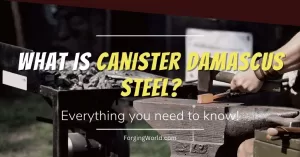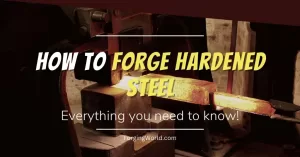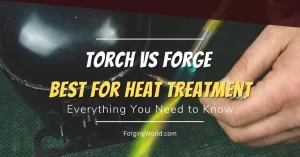Forge welding is one of those things that many beginners get all freak out about. Some of them even believe it is an ancient mysterious welding technique which is so hard to learn it is not even worth trying. However, this is far from the truth. Forge welding is actually a fundamental blacksmithing skill, it always has been and it always should be.
Since I heard many people wondering whether forge welding is strong, I decided to write this article which will provide you with an answer to that question. Here is the short and direct one:
Forge welding is a strong welding technique which homogenizes the material at the joint. Blacksmiths used forge welding technique for hundreds of years which allowed them to make some incredible projects. The more experienced you are, chances are the stronger the weld will be.
Note that the quality of the forge weld depends on the various factors such as metal preparation, fluxing, right timing, fire management, etc. In the rest of the article, I will talk about these influencing factors, compare forge welding with other welding techniques and finally how to improve your forge welding.
Ok, enough of the intro, let’s get right in.
Influencing Factors
Forge welding is essentially heating two pieces of material up to forge welding temperatures and fusing them together. These temperatures are near the melting point, so before you start, make sure your forge is capable of reaching such high temperatures. As I have already said, the quality of the weld, meaning how strong it is, depends on the following factors:
- Material selection
- Material preparation
- Flux
- The fuel
- Timing
Material selection
First and foremost, choosing the right material for forge welding is vital. It doesn’t matter whether you have 20 years or 2 days of experience if you choose materials that cannot be forge-welded together forget about it. Not just that you won’t get a good weld, but you won’t get a weld at all. Trying to forge weld steel to titanium is one example.
Some materials don’t like each other in terms of forge welding. This is why you should always take some time to research the materials you plan on forge welding. Wrought iron, mild steel, and high-carbon steel are some of the most popular materials used for forge welding purposes. Also, make sure to check the forge welding of a particular material. For instance, mild steel requires a much higher forge welding temperature than high-carbon steel.
Material preparation
After you researched and chosen the appropriate material, it is time to prepare it for forge welding. The scale and other impurities on the surface of the material are the biggest enemies to forge welding. This is why the material must be clean before you weld it. If your metal has a lot of rust, you can soak it in vinegar. When you heat up the piece, make sure to brush out the scale on the surface before applying any flux. The cleaner the material, the stronger the weld.
The number of heat should also be mentioned here since it greatly influences the quality of a weld. In most cases, 2-3 heats are done. Note that the number of heat depends on the size of the material. One heat would be too little.
Flux
The use of flux is extremely popular in forge welding, especially among beginners. The primary use of flux is to lower the temperature at which scale and other surface chemicals become fluid. Basically, flux protects the surface of the material from erosion. Keep in mind that the use of flux is not always mandatory. For instance, you don’t need flux when forge welding two pieces of mild steel. Similarly with wrought iron.
Just like mild steel, wrought iron is also self-fluxing. Flux is typically used when forge-welding high-carbon steel to mild steel. The process goes much better when you add flux. The reason for that is flux lowers the melting point of mild steel and matches the high carbon melting point.
Another scenario where the flux is typically recommended is when working on the more complex joint like blending in the toes of scars. In most cases, flux makes the process of forge welding much easier. If you are using a propane forge, chances are you will need to use flux, since some gas forges cannot reach forge welding temperatures.
If you are a beginner, I suggest using flux because there is always a possibility of a small film of rust forming on the surface of the metal. The vast majority of people getting started with forge welding are already intimidated. Doing so without a flux would make this problem even worse. In most cases, the use of flux increases the possibility of a strong weld.
Fuel Type
The choice of fuel is another crucial factor in forge welding. There are many possible fuels you can use for this purpose, however, two of them are used the most: coal and propane.
We could say that the coal forge is capable of reaching higher temperatures than the gas forge in most cases. On the other hand, forge welding in the coal forge requires the knowledge of proper fire management. If you don’t know how to work with coal, don’t use it. This is exactly why so many beginners are starting to use propane forge.
If you do use coal forge, you want to be burning coke, not green coal. You want your fire burning hot and clean, so make sure that you spread coke around all sides of your billet. Note that forge welding in this type of forge can be difficult to heat the material evenly. My recommendation is to concentrate on one section of your billet at a time. After you finished with the first section, move on to the next section.
Also, heating your material slower is more important in a coal forge than in a propane forge. Namely, in a coal forge, it is so easy to heat one area and burn it. I recommend a low to medium airblast which will bring the metal to a high orange.
On the other hand, if you use a propane forge notice the flame exiting the forge door. If you don’t see any flame, your propane is being burned up which means you have an oxidizing atmosphere. A small flame indicates a neutral atmosphere. Lastly, if you have a long flame, it means you have a reduced atmosphere. Keep in mind that blue flame generally refers to the production of carbon monoxide.
Timing
Finally, we have a timing of taking out the metal from the forge. Knowing when to take it out is so important that I can’t stress this enough. If you take it out early, the metal will be cold and won’t be able to weld. On the other side, if you take it later, you might burn your material and prevent a weld from happening. There are two main ways of knowing when it is the right time to weld.
The first one is to observe the flux. When the flux is “boiling” on the surface, it is typically the time to weld. The other way is to simply observe the color of the material. What you are looking for is a bright orange-yellow color. Knowing exactly when to weld will increase the chances of making a strong weld.
Forge Welding vs Stick Welding
In order to better understand how strong forge welding actually is, we must compare it to another popular welding method. In this case, we will compare it with Stick welding. Ok, what is stick welding?
Stick welding (SMAW) is a welding method that is performed by striking an electric arc between the workpiece and the metal electrode. This is how it works. An electric current goes through the electrode and melts into the material forming a weld pool. After that, a layer of flux that protects the weld pool from contamination covers the electrode. The layer of slag is formed by a flux. This slag is formed on top of the weld bead which has to be brushed down after completion.
With a stick weld, you heat a tiny area extremely hot very quickly. Since such a tiny area is heated, the rest of the material acts as a heat sink which causes the metal around the joint to harden. Just as it was quenched in water. This is especially a problem with stick welding high carbon steels which can result in a brittle join. Note that high-carbon steel also gets a coarse grain structure from stick welding which makes the material brittle.
This is the reason why preheating and post-heating are crucial when doing this method of welding. However, even then you don’t have the same surface area as you would have with forge weld.
Advantages
- Portable
- Convenient for outdoors
- Easier to learn
- Welding on metal with rust or scale
Disadvantages
- Produces a lot of slags and spatter
- Decreased efficiency due to the increased cleanup time
- More expensive
On the other side, you have forge welding. Welding technique that many blacksmiths often avoid learning. It is generally harder to learn as no power tools are used. Most blacksmiths will tell you that forge welding is better than stick welding because forge welding is “self-annealing”. With forge welding, the material typically doesn’t get near melting temperature. Once you make the weld, you simply let it cool down slowly which will relieve the stresses.
The faggot weld is one of the simplest forge welds. And no, that is not an insult to anybody’s sexuality, so you can keep those kinds of comments to yourself. It is a blacksmithing term that means stacking the material on top of each other. Damascus is just that. You stack everything up, weld it together and draw it out.
Advantages
- Cheap
- It welds both similar and dissimilar metals
- No filler needed
- Doesn’t require expensive equipment
Disadvantages
- Not ideal for large items
- Harder to learn
- Suitable for steel and iron (mostly)
- Slow



